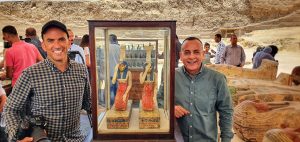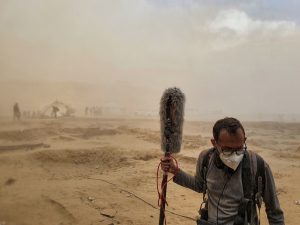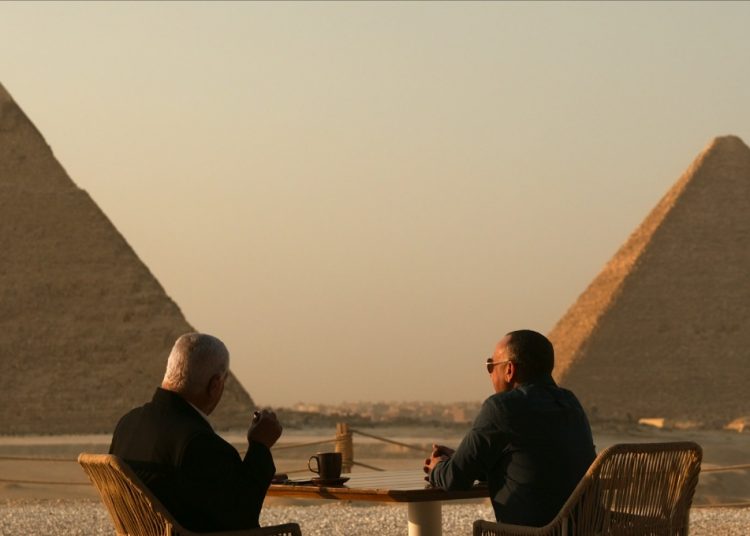On July 3, Netflix will premiere the documentary Unknown: The Lost Pyramid featuring two famous Egyptologists Dr Zahi Hawass and Dr Mostafa Waziry.
The trailer informs us: “In the sands of Saqqara, the latest Egyptian archaeological hotspot, two of the world’s most famous Egyptologists seek to unearth ancient treasures. The legendary Dr Hawass hunts for the long-lost pyramid of a forgotten Egyptian king while his protege and rival, Dr Waziry, searches for an unlooted tomb in an ancient necropolis. Both teams race against the clock to see who will make the bigger discovery and make their mark in history.”
The Egyptian Gazette interviewed director Max Salomon to learn more about what makes Unknown: The Lost Pyramid a documentary different from any other of its kind, what the filmmaking techniques were, the challenges he faced while shooting in the Saqqara desert, and the moments that made a profound impression on him.
Salomon is an Emmy award-winning director and producer of documentaries for Netflix and National Geographic.

EG: Why did you agree to direct Unknown: The Lost Pyramid? What makes this documentary different from others on archeology? How long did the filming take?
S: What excited me about this project is that from the first moment it was clear that this film was going to be different. The team at Netflix and producers at Story Syndicate & Big Dreams asked me to devise a new approach to the traditional archaeology TV documentary. Most productions of this type have the voice over by a narrator reading the historical facts while the viewer sees footage of archaeologists filmed in a few days or weeks. We had something altogether different in mind.
We wanted the film to be a cinematic epic that felt as big and dynamic as an Indiana Jones adventure on the big screen. No narrator, just a film that immerses the audience in the real drama of the people and scientists in front of the camera struggling against the desert environment, compounded with the thrill of the search and the moments of discovery. This is the story of one of the greatest finds of our times. We wanted the film to feel different, unlike anything seen before. Netflix was willing to put the resources behind the film to capture that story. Instead of just a few weeks of filming, we would film for 43 days spread out across an entire year. That’s almost unheard of in our industry these days, added to that the fact that we would be working with the legendary Dr. Hawass, who is not only a remarkable archaeologist but also a fascinating personality, as he sets out to make what may be the biggest discovery of his career. So, when someone comes to you with that kind of proposal, any director would jump at the chance.
I arrived in Egypt in the autumn of 2021. From the moment my producer and I stepped out into the sand we discovered that the story unfolding in front of us was even more exciting than we had imagined. We could start the story before a shovel made its first cut into sand. The film begins with Dr. Hawass looking out into the desert at an area of Saqqara no archeologist has ever touched. This is an area he has been dreaming of excavating for decades. What could be under all that virgin sand? What we found exceeded our wildest hopes.
The camera captured the moments when Dr Hawass finds the oldest intact mummies of some of the highest officials in ancient Egyptian society ever discovered in Egypt. Here unfolds a series of discoveries that build on each other to lead to what could be the discovery of the century: one of the largest structures discovered at Saqqara in over a 100 years.
To be able to tell that full story in a single film was truly a dream come true.
The filming and editing took a total of two years and I’m thrilled to share that story when the film premieres on Netflix on July 3.

EG: What is your experience with working with two famous Egyptologists?
S: As a documentary director, building a close bond with your subjects is critical. They need to trust you, so you can shape the story together as it unfolds in front of the camera. For me, working with Dr Hawass and Dr Waziry was a dream come true.
Dr Hawass is a legend. They call him “the pharaoh” for good reason. He is an icon. At first he can be a bit intimidating. But we quickly grew to trust and like each other. Dr Hawass has made over 300 documentaries but he never spends more than a few days with any one filmmaker. His time is very valuable. But he invested in our project in ways I think he never has before: 43 days of filming in sandstorms and merciless heat. I can’t thank him enough for his trust, patience and friendship. That kind of relationship with a subject comes across on the screen.
Dr Waziry is incredibly energetic. I’ve never met a man who moves so fast. He is in so many places at once. He’s incredibly charming and approachable and very enthusiastic. He is in many ways almost like a son to Dr Hawass and working with him revealed new sides to me of what it means to be an archaeologist.
EG: Is the film only about the discoveries made by Dr Hawass and Dr Waziry?
S: Unlike other documentaries this film is not merely about the spectacular discoveries, but about the people behind them and the relationships between them. We set out to understand what it takes to be an archaeologist, how a discovery is made, the commitment and passion required to be successful. But beyond that it’s also about our legacy after we are gone. To reveal that theme we chose to follow and interweave two stories: Dr Hawass’s quest to find one of the most iconic lost pyramids of the Old Kingdom and Dr Waziry’s exploration of an unlooted tomb. Dr Hawass and Dr Waziry have a close personal relationship almost like a father and son in many ways, or the master and his student. Both men are also driven by a deep commitment to a single purpose, which is that the future of Egyptology belongs to Egypt. For centuries foreign archaeologists were the only ones to make discoveries in this country. Dr Hawass has spent a lifetime elevating Egyptian archaeologists to not merely compete with foreigners but to reclaim the science of Egyptology itself. Dr Waziry is in many ways a extension of that legacy. While their dig sites are not connected, they are after the same goal: to reclaim Egyptology for Egyptians and ensure that the next great find is made by Egyptians. Although Dr Hawass and Dr Waziry are the stars, they are supported by a cast of Egyptians who work for them and who help tell the story.
The film is also in large parts shot in Arabic. I wanted the story of the film to be told by Egyptians in their own words; not by foreigners speaking in a foreign language. There is a beauty and poetry to Egyptian Arabic that I love. Netflix has had the films translated into dozens of languages for release in 190 countries on July 3.

EG: Which filmmaking techniques did you use? What about the locations?
S: We worked with the highest quality cameras and some of the best directors of photography and camera technicians in the industry. Our film is shot in the same widescreen as “Lawrence of Arabia”. Visually this film feels like nothing you would normally see on TV. The desert is a stunning location in that format. But that environment was also the biggest challenge. The desert is beautiful but also a brutal, unforgiving place. We even filmed through two sand storms, which I will never forget. It felt as if we were on a sinking ship with giant waves of sand crashing in. At the end of every shoot, we and our equipment were covered in dust. However, the magical moments we were able to capture at the sites at Saqqara made it all worthwhile.
EG: What about the challenges you face?
S: The locations. Imagine, almost every day we had to be lowered on ropes down narrow shafts into 4,300-year-old tombs up to 25 metres underground. These are tombs that no one has been in since they were sealed thousands of years ago. They are filled with precious artefacts. You have to be extremely careful. One wrong move and either you or a precious artefact will be destroyed.
These freshly unearthed sites aren’t like the Pyramids of Giza that have been secured and retrofitted so tourists can safely enter them. These tombs are fragile and sometimes can be unstable. We were filming in a tomb at Dr Waziry’s site when suddenly rubble cascading from an upper chamber into a shaft. We had to evacuate and stop filming for four days while the team carefully dug out the 40 cubic metres of dangerous debris.
Another time, Dr Hawass noticed a four-centimetre wide crack in the ceiling above us and we had to lower the lid on a giant sarcophagus we had just opened and stand back so that workmen could stop the ceiling from collapsing onto us.
But there’s also a magic in these locations. You are there the moment that the seal to a tomb is broken open. Your flashlight is the first beam to penetrate the darkness after 4,000 years. It takes your breath away.

EG: What scenes impressed you most?
S: There are a lot of amazing moments in our film. From the beginning with Dr Hawass standing in an empty desert at sunset wondering what he will find… hoping that he will find the lost pyramid of an ancient king from the earliest days of the Pyramid Age… through a chain of stunning discoveries that leads him like a trail of clues to the end when we discover one of the largest structures ever found at Saqqara.
But my favourite parts are the moments in which we witness Dr Hawass make history. In front of our cameras Dr Hawass discovered some of the oldest fully intact mummies ever found in Egypt. These are mummies that are over 1,000 to 1,500 years older than those of King Tut, Ramses and the other royals of the 18th Dynasty. Most of the mummies that are that old – be they of kings or high officials – are in terrible condition… and hardly ever undisturbed and intact. But these were perfectly preserved, covered in stunningly beautiful beads and glittering gold. One of the archeologists on the team said to us that he wonders – had he been alive four and a half thousand years ago – if he would have been permitted to even stand in the presence of these people. To stand in the presence of those people even today is an honour. It truly takes your breath away. But that discovery is only the beginning of something even bigger which you’ll have to see for yourself at the end of the film.








Discussion about this post